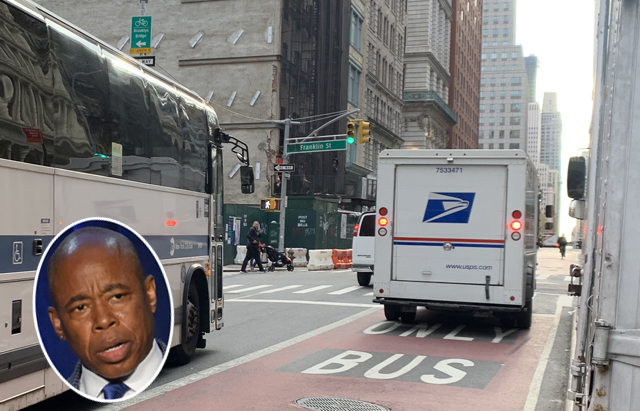
They're not going to make it.
The Department of Transportation has finally confirmed what Streetsblog has been reporting for months: It will not build the 30 miles of new protected bike lane and 20 miles of dedicated bus lanes required by law this year.
An email from agency spokesman Vin Barone confirmed the numbers: By the end of 2022, the agency expects to complete over 25 miles of new protected bike lanes, though work to get to that number remains ongoing, Barone said, promising more announcements before Dec. 31. (The DOT did not provide a breakdown of all 25 lane miles.)
On bus lanes, where the city is required to build 20 miles of protected bus lane — which can mean barriers or camera enforcement — Barone gave the following breakdown:
- New dedicated bus lanes on University and Tremont aves in the Bronx, avenues A and D in Manhattan, 21st Street in Queens and a short stretch in Pelham Bay Park in the Bronx amounted to 5.37 miles.
- Enhanced bus lanes on First and Lexington avenues in Manhattan, the Main Street Busway in Queens and the EL Grant Highway in The Bronx amounted to 2.4 miles.
- Camera enforcement on existing bus lanes added 4.2 miles.
So the total new and enhanced lane miles adds up to 11.95 miles.
That number is significantly lower than the 20 miles required under the Streets Plan, which went into effect this year. That plan, according to the DOT itself, not only required the 20 miles of protected bus lanes and 30 miles of protected bike lanes, but also upgrades to 500 bus stops (such as shelters, benches and bus time poles, transit signal priority at 750 intersections, accessible pedestrian signals at 500 intersections (the DOT said it just missed that one), 500,000 new square feet of pedestrian space, and 400 redesigned intersections. (The DOT did, in fact, redesign far more than 400 intersections this year, and did meet its transit signal and accessible pedestrian signal targets.)
The DOT said its bus improvements improved commutes for 401,000 riders, but advocates were displeased.
"Getting stuff done shouldn't mean splitting hairs," said Danny Pearlstein, the spokesman for Riders Alliance. "The Adams administration is many miles wide of the mark when it comes to complying with the Streets Plan and keeping the mayor's promise to millions of riders, overwhelmingly low-income New Yorkers of color, who are still stuck on America's slowest buses after several decades of unjust public policies that must be remedied. Better buses are the linchpin of the 'City of Yes' and should top the list of Mayor Adams's New Year's resolutions."
Like Riders Alliance, Transportation Alternatives has been keeping a tracker to assess DOT's successes this year. It currently lists far fewer lane miles than the DOT claims it will reach. As such, the group's Executive Director Danny Harris said, "The city needs to meet these goals without delay or excuse and stop leaving New Yorkers who walk, bike, and bus behind."
Bus speeds on New York City's car-filled roadways has been a thorny problem for virtually all mayors. But under Mayor Adams, who has vowed to be a "bus mayor," speeds of local rush-hour service have not substantially improved, going from the 7.2 miles per hour they averaged citywide when Adams took office to the 7.3 miles per hour the MTA reported in July (the last available month).
Mayor Bill de Blasio's bus speed average also did not change from 7.2 peak MPH he inherited to the 7.2 MPH speeds he left to his successor, according to MTA numbers.
It is unclear why the DOT did not make its targets. Staff shortages have hampered the agency throughout the year. And Streetsblog reported in September that DOT was contending with a high vacancy rate, which employees attributed to low morale, difficulty hiring, frustration with in-office work requirements and the leadership of Commissioner Ydanis Rodriguez.
The strain caused by vacancies could be here to stay. The Office of Management and Budget has ordered city agencies to eliminate half of their vacant positions. Depending on which vacancies at DOT are cut, the directive could present another hurdle to meeting the Streets Plan requirements, former DOT official Jon Orcutt told Streetsblog earlier this year.
“Invariably you’ll do less with less,” said Orcutt, now the director of advocacy for Bike New York.
It is also unclear if the City Council will do anything to enforce the Streets Plan that it passed, and de Blasio signed into law (which contains no enforcement provision). Last month, a Council spokesperson did not respond to a question about what action the legislative body will take, but the spokesperson conveyed the Council’s frustration.
“The Council enacted critical legislation requiring the city to build bus lanes to improve commutes for riders,” the spokesperson said in a statement. “Staff shortages and unfilled vacancies in key agency positions, including planners and laborers, impact the delivery of municipal services with repercussions for New Yorkers, which is unacceptable. It is critical for the administration to fill vital roles that ensure agencies fulfill their requirements within the law and to communities.”
As Streetsblog also reported last month, the DOT does not believe it will be able to reach other Streets Plan benchmarks for bus lane mileage going forward, with the agency informing City Hall and the Metropolitan Transportation Authority that it will struggle to build the 30 miles of new bus lanes it is required to build next year, according to three officials.
We reached out to the Council and will update this story with a new comment if we hear back.






